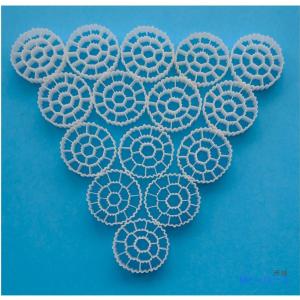

Add to Cart
The Moving Bed Biofilm Reactor (MBBR) has emerged as an innovative and efficient wastewater treatment process for both domestic and industrial applications. This article focuses on the use of MBBR biological filler bio carriers, specifically the 30×10 size, in sewage treatment systems. The compact design, cost-effectiveness, and high treatment efficiency of MBBR make it an attractive option for addressing the challenges of wastewater management.
Due to early issues with biofilm reactors, like hydraulic instability and uneven biofilm distribution, moving bed biofilm technology was developed.
The MBBR system consists of an aeration tank (similar to an activated sludge tank) with special plastic carriers that provide a surface where a
biofilm can grow. There is a wide variety of plastic carriers used in
these systems. These carriers vary in surface area and in shape, each offering
different advantages and disadvantages.
The surface area plays a very important role in biofilm formation.
Free-floating carriers allow biofilms to form on the surface,
therefore a large internal surface area is crucial for contact with
water, air, bacteria, and nutrients. The carriers will be mixed in the tank by the aeration system and
thus will have good contact between the substrate in the influent
wastewater and the biomass on the carriers
The most preferable material is currently high-density polyethylene
(HDPE) due to its plasticity, density, and durability.
To achieve a higher concentration of biomass in the bioreactors, hybrid MBBR systems have been used where suspended and attached biomass co-exist contributing both to biological processes.
Large specific surface area, more attached microorganisms
No need bracket, easy to fluidize, save energy
Fast and easily to hang membrane, high biological activity
Strong impact resistance, long lifetime
Excellent nitrogen and phosphorus removal effect
Small footprint, simple and flexible operation management
Good hydrophilicity, good treatment effect
Relying on biofilm treatment, reduces the remaining sludge
Today, MBBR technology is used for municipal sewage treatment, industrial wastewater treatment, and decentralized wastewater treatment. This technology has been used in many different industries, some of them being:
The MBBR system is considered a biofilm or biological process, not a chemical or mechanical process. Other conventional biofilm processes for wastewater treatment are called trickling filters, rotating biological contactors (RBC), and biological aerated filters (BAF).
Biofilm processes in general require less space than activated sludge systems because the biomass is more concentrated, and the efficiency of the system is less dependent on the final sludge separation.MBBR systems do not need recycling of the sludge, which is the case with activated sludge systems.
The MBBR system is often installed as a retrofit of existing activated sludge tanks to increase the capacity of the existing system. The degree of filling of carriers can be adapted to the specific situation and the desired capacity. Thus an existing treatment plant can increase its capacity without increasing the footprint by constructing new tanks.
Some other advantages are:
Higher effective sludge retention time (SRT) which is favorable for nitrification
Responds to load fluctuations without operator intervention
Lower sludge production
Less area required
Resilient to toxic shock
Process performance independent of secondary clarifier (due to the fact that there is no sludge return line).
Q: Can you accept mixed batches of different products?
A: Yes
Q: What is the lead time of an order?
A: About 7-30 days
Q: Can I have a sample order?
A: No
Q: What's the delivery time?
A: About 30 days
